Artocarpus integer
| Artocarpus integer | |
|---|---|
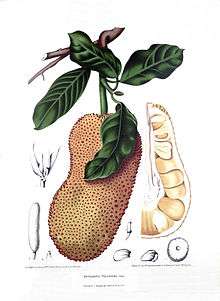 | |
| Scientific classification | |
| Kingdom: | Plantae |
| Clade: | Angiosperms |
| Clade: | Eudicots |
| Clade: | Rosids |
| Order: | Rosales |
| Family: | Moraceae |
| Genus: | Artocarpus |
| Species: | A. integer |
| Binomial name | |
| Artocarpus integer | |
| Synonyms | |
| |
Artocarpus integer, commonly known as cempedak (pronounced "chem-pe-da"), is a species of tree in the family Moraceae, and in the same genus as breadfruit and jackfruit. It is native to southeast Asia, especially from Malaysia and can be found in Indonesia to the island of New Guinea. Furthermore, the tree has also been introduced to Queensland.
Description
Cempedak trees are large, evergreen trees. They can grow to a height of 20 m, although most only reach a dozen meters. The trees are monoecious, with male and female flowers growing on the same tree. There are many varieties, although few are named. The vigorously growing tree can bear heavy crops of fruit once or twice a year.
Fruit
The syncarp may be cylindrical to spherical in shape, and ranges from 10 to 15 cm across and 20 to 35 cm in length.[1] The thin and leathery skin is greenish, yellowish to brownish in color, and patterned with pentagons that are either raised protuberances or flat eye facets.
The fleshy, edible arils surround the large seeds in a thick layer. These arils are edible by boiling or roasting. Arils are yellowish-white to orange in color, sweet and fragrant, soft, slippery and slimy on the tongue and a bit fibrous. The taste of the fruit is similar to the related jackfruit and breadfruit with a hint of durian. The seeds are flattened spheres or elongated, about 2–3 cm in length.
Uses
The fruit is consumed in its native area, can be eaten fresh or cooked. The seeds can be fried, boiled or grilled, then peeled and eaten with salt. The taste is similar to water chestnuts. The young fruit, like young jackfruit, can be used as a vegetable.[1] In Borneo, the skin of the cempedak can be processed into food called mandai made by peeling the fruit until it looks white, then soaking it in brine to preserve and soften the texture. Mandai is usually consumed after frying.[1]
The wood is of good quality, strong and durable, and used as building material for home furnishings or boats. The fibrous bark can be used to make ropes. Yellow dye can also be produced from the wood.[1]
Gallery
Matured Cempedak ready to be harvested |
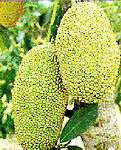 Cempedak fruit on tree |
Whole cempedak fruit |
Cempedak fruit - whole and sliced |
 Cempedak fruit cut open |
Cempedak fruit cut open |
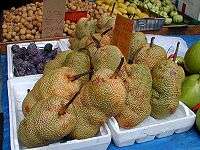 Cempedak on sale in Chinese market. |
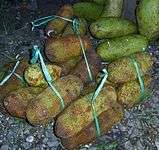 Cempedak on sale at roadside in East Kalimantan, Indonesia |
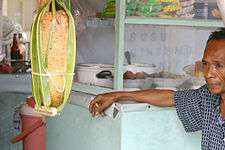 A cempedak fruit stall |
See also
References
External links
For more information, see "Fruits of the Future: Chempedak" by David K. Chandlee
| Wikimedia Commons has media related to Cempedak. |
| Wikispecies has information related to Artocarpus integer |